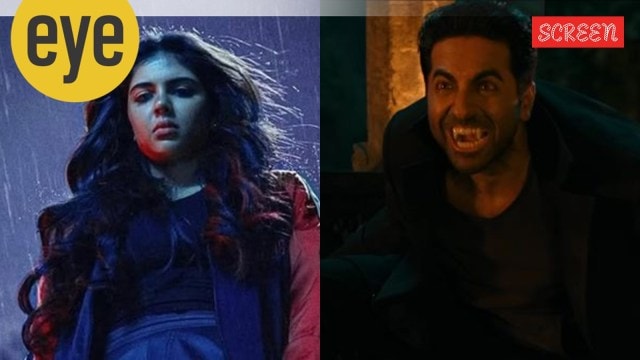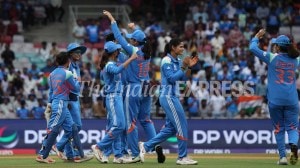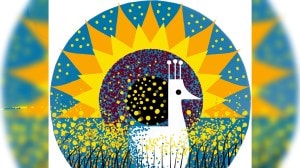Click here to follow Screen Digital on YouTube and stay updated with the latest from the world of cinema.
From Thamma to Lokah: Indian cinema’s vampire boom rakes in the big bucks
As vampires reclaim their place in mainstream cinema, a closer look at how they have reinvented themselves through the centuries and why filmmakers are once again sinking their teeth into these narratives.
 The nature of vampire stories allows filmmakers inventive ways to present their characters and weave in social commentary.
The nature of vampire stories allows filmmakers inventive ways to present their characters and weave in social commentary.After doctors give up and pronounce him dead, the man vanishes from his bed only to be discovered ravenous inside the hospital’s blood bank. He rips open packets containing blood with his “punching-machine-like teeth” and guzzles it down. He effortlessly scales highrises and beats up any baddie he encounters. Yet, sunlight makes him recoil. His newly-developed pallor and appetite suggest a supernatural transformation: He may have exhaled his final human breath but he has respawned as a vampire.
The story of this newly-fanged protagonist, who romances an alluring female vampire, is at the heart of the just-released film Thamma. With it, Maddock Films’ Maddock Horror Comedy Universe (MHCU) ventures into vampire territory for the first time, after previously populating its world with witches, a headless demon, a ghostly creature and bhediya (Hindi cinema’s spin on the werewolf). Released on October 21 as a Diwali-week family entertainer, Thamma arrives at a time when vampire-led narratives, both international and homegrown, are enjoying a resurgence. Led by Ayushmann Khurrana and Rashmika Mandanna, the vampire romance has earned over Rs 55 crore in India during the first three days of its release, notwithstanding mixed reviews. The makers are already teasing a larger crossover ahead — one that could stage an on-screen face-off between bhediya and vampire in future instalments of MHCU.
Unlike the West, where the filmmakers have periodically used horror as a tool to shock, subvert and provoke reflection, the horror genre in India has taken a long time to shed its ‘B-grade movie’ tag and move beyond jump-scare, sleaze and gore. Today, mainstream cinema has not only embraced it as a potential blockbuster material but also drawn A-listers to come onboard. Little wonder that Indian filmmakers, who swear by “entertainment”, are serving horror movies, for the second consecutive year, as crowd-pullers amidst Diwali celebrations after last year’s horror-comedy Bhool Bhulaiyaa 3.
From the beginning, reveals Thamma’s director Aditya Sarpotdar, it was decided that the movie would be a Diwali release. “On the eve of Diwali, when a family gets together and decides what movie to watch, they should want to watch Thamma. So, when that is a clear agenda, I feel you have to entertain the audience while you bring in all these other elements of mystery and intrigue without making it too dark,” says Sarpotdar, who also directed last year’s surprise hit Munjya (2024).
Indian filmmakers, encouraged by the audience’s appreciation for movies like Tumbbad (2018), Stree (2018), Bramayugam (2024) are undoing decades of dismissive attitude towards the horror genre with a new-found interest in vampire-led narratives. Released on August 25, the Malayalam-language Lokah Chapter 1: Chandra, produced by Dulquer Salmaan and directed by Dominic Arun, apart from generating incredible buzz and acclaim, grossed Rs 300 crore globally. This makes it the highest-grossing Malayalam film ever as well as one of the biggest Indian films to feature a female lead, Kalyani Priyadarshan, who plays the titular lead and a centuries old yakshi with vampire-like features. During the end credit roll, Lokah teases the audience with a glimpse of two of Malayalam cinema’s biggest stars — Tovino Thomas and Dulquer — appearing as supernatural beings in the second instalment of this five-part ambitious franchise.
Vampires have seized the spotlight as evident from some of the biggest film releases of 2025. After a Christmas Day opening in America last year, Robert Eggers’s gothic vampire horror Nosferatu kicked things off in India with a January release. This remake of Nosferatu: A Symphony of Horror (1922), the iconic German Expressionist vampire tale by FW Murnau, earned four Oscar nominations for Best Cinematography, Best Costume Design, Best Production Design and Best Makeup and Hairstyling this year. Considered to be a visionary director, Eggers calls Nosferatu — a tale of obsession between a haunted young woman (Lily-Rose Depp) and the vampire Count Orlok (Bill Skarsgård) infatuated with her — his “most personal” project.
Released in April, Ryan Coogler’s Sinners drew instant acclaim for its original vision. This southern-gothic vampire musical, set in the 1930s, is steeped in Black history, magic of blues and vampire folklore. The Smokestack twins, Smoke and Stack (both the characters are essayed by Michael B Jordan) return to their hometown to make a fresh start, only to discover that an even greater evil is lurking to ruin their plan. Sinners, apart from amassing about $362 million worldwide, has emerged as an Oscar frontrunner in multiple categories, including Best Picture and Best Director, alongside Paul Thomas Anderson’s One Battle After Another. On October 30, the movie is returning to select Imax theatres for a week-long Halloween run.
One of the timeless literary works, Bram Stoker’s 1897 classic novel Dracula, has inspired many retellings and spin-offs as well as laid out the template for portrayal of vampires onscreen. The central character of Count Dracula, an aristocrat, who is sustained by the blood of others, also became a metaphor for political and social critique. It gained currency especially after Karl Marx, while criticising unpaid work wrote in his book Das Kapital: ‘Capital is dead labour, which is vampire-like, lives only by sucking living labour, and lives the more, the more labour it sucks.’
Many vampire stories and horror movies have sunk their teeth into the ills of capitalism the way Sinners does. Others like Ana Lily Amirpour’s debut feature A Girl Walks Home Alone At Night is about a female vampire, who stalks potential victims, mainly immoral men, in a fictional Iranian town called Bad City. Oscar-winner Kathryn Bigelow, too, made her debut with Near Dark (1987), which is described as an artsy vampire Western and is about living on the edge. Author Anne Rice humanised vampires in her popular novels and the film Interview with the Vampire (1994), based on her book, deals with existential themes. Experiments with the vampire sub-genre continue as romantic fantasy Dracula: A Love Tale was released in France while action-horror Dracula: Rise of the Vampire was released in the United Kingdom.
The nature of vampire stories is such that it often allows filmmakers and storytellers inventive ways to present their characters and weave in social commentary. According to gothic literary professor and gender and sexuality studies expert Dr Laura Westerngard, vampire characters have evolved constantly. “Nosferatu introduced the concept of a vampire who is destroyed by sunlight. Dracula can go out during the day…There is a long history of vampires, a metaphor of disease. Maybe a vampire represents someone with porphyria, where you can’t go outside into the sunlight.”
Unlike in the West, these bloodthirsty characters have not invaded pop culture and intellectual discourses in India, even though Indian folklore and mythology are teeming with such supernatural beings. The one who comes close to the Dracula-like figure in our folklore is Betaal — a spirit that possesses dead bodies and hangs upside. Its earliest references appear in the 11th-century Kathasaritsagara, which include stories known as Vetala Panchavimshati. Richard Burton, a British explorer, retold these stories in a book titled Vikram and the Vampire or Tales of Hindu Devilry in the 19th century. Talking about this, Anuja Chandramouli, an author of fantasy and historical fiction, says: “Betaal is more closely associated with vampires because it was Burton who mentioned Betaal as a vampire. He wasn’t exactly going for scholarly precision. Since vampires were already popular in the West, he went for that term. However, Betaal is close to a spirit, has a lot of depth and a sense of good and bad.”
Interestingly, Devi Bhagavatam, says Chandramouli, features three types of female vampires — Pumscalis, Svairinis and Kaminis. They seduce any man who wanders into Atala, the highest of the seven lower realms of Patala, which is ruled by Bala, the son of Asura Maya. “In India, we have that binary concept about good and bad girls. So, we have cautionary tales about expressing your desires. Interestingly, Dracula is the male vampire, who bites young girls’ necks, an erogenous zone, with his fangs. Because Indian girls are sheltered, we are told cautionary tales in which men have no freedom to explore their desire,” says Chandramouli. However, a movie like Thamma, says the author, by turning the narrative into a vampire romantic saga that talks about eternal love, does away with the dark elements. “Then, everybody’s in for a fun ride,” says the author of Mohini: The Enchantress and Abhimanyu: Son of Arjuna.
In any case, vampire tales were not always meant to scare. Much before Dracula, there was The Vampyre, first published anonymously in 1819, with the central character called Lord Ruthven, a caricature of poet Byron. Written by his personal physician John Polidori, this story was meant to make fun of Byron, who had acquired a reputation as “a scandalous celebrity” and “an aristocrat of great dignity but also as a moody romantic”. The story was not fleshed out properly as it was dashed off for a ghost-story competition. Mary Shelley (then Mary Godwin) won the competition with Frankenstein. Later, Polidori reworked this story, which helped in the evolution of the vampire from a folkloric creature into an aristocratic seducer.
The success of Thamma and Lokah might shift the perception regarding vampires and pave the way for their comebacks on the big screen in India. “Overall, India has not produced many horror movies with big stars, barring some films like Bhool Bhulaiyaa (2007) and Go Goa Gone (2013). Until the first Stree released, we had not explored this genre properly. Now, actors have also realised its potential. But I believe if you look at pure horror, it is more niche and does not appeal to a family audience,” Sarpotdar says and cites Shaitan (2024) as an exception, in which Ajay Devgn, Jyothika and R Madhavan did a pure horror film.
What is remarkable about the recent Indian horror films is that, while developing their narratives, they mine regional folklore, rituals and history. In Thamma, for instance, Alexander and his army are attacked by a clan of betaals led by Yakshasan (Nawazuddin Siddiqui). These betaals later become instrumental in India’s freedom struggle. The film also invokes the legend of Raktabija from Devi Mahatmya. Unlike the Western vampire whose bite turns humans into vampires, Raktabija’s spilled blood generates his clones wherever a drop falls. Lokah draws on the story of Kalliyankattu Neeli — a tribal girl whose village was destroyed by an oppressive king. After being bitten by a bat, she gains supernatural abilities, which the film uses as Chandra’s origin myth.
The vampire genre has firmly established its popularity and box-office draw. Its versatility has also lent itself well to long-form storytelling, as seen in television shows such as The Vampire Diaries (2009–2017) and True Blood (2008–2014). It even produced a global phenomena such as The Twilight Saga, a five-film franchise that follows Bella Swan, an awkward teenager who falls in love with a vampire.
Evidently, for filmmakers, this offers immense scope to experiment with tropes and push genre boundaries. For the audience, it provides a thrilling space to confront fears and experience an adrenaline rush. By including vampire-like beings, storytellers can craft narratives that are at once wildly entertaining and intellectually provocative.






- 01
- 02
- 03
- 04
- 05


























